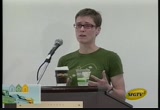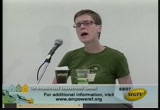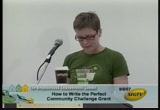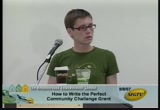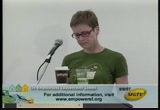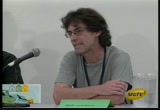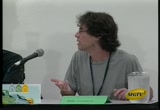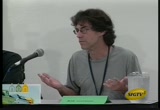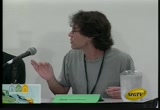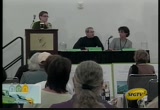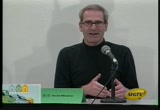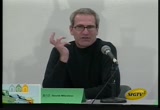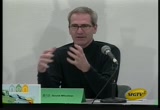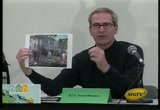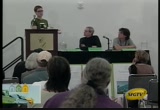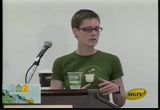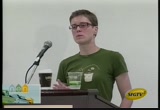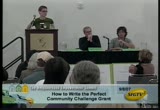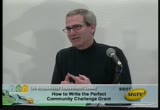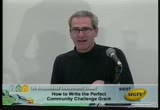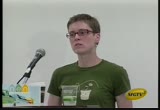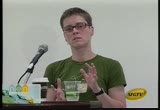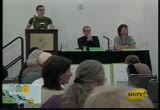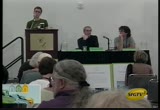tv [untitled] September 23, 2010 12:30am-1:00am PST
1:30 am
it's not something you that you can involve the community. community will not build a bathroom or maintain a bathroom for 5 yeeshs. they might but that was not the application submitted. >> let's talk about briefly the match because that has to be that requirement has to be met before we talk about the scoring. the point of the match the reason the program was retooled and called the community challenge grant is the idea is to encourage neighborhoods to value themselves and their own work. the grant is unique in the city and in many other cities in that we have placed a dollar value on your volunteer time of 14 dollars an hour. you are allowed to include your volunteer time as the match. as a committee we more strongly
1:31 am
favor neighborhoods that come in with the bulk of their volunteer match made up with volunteer time rather than dollars. some projects come in and have the required match and it's cash from a big corporation. that's fine it doesn't show community challenge had is what we are interested in. it's unclear the dollars from the corporation match how the community will sustain that. are you hoping you will get an equal match from the corporation. we don't know. when you submit your budget and documented volunteer hours and given us a sense of hathey look like. that's what we really like. and the volunteer hours can be inunskilled labor or professional services those canning volunteered up to 70 dollars an hour.
1:32 am
if you have an architect in the neighborhood donating their designs that's a 70 dollar value. you can quickly come up with a nice match if you have a robust community. that is the selling thing the more you have the more you can do and the more likely you will get our grant and several grants. and then you go to other grants from other institutions like san francisco beautiful. so then to further emphasize the community challenge portion of the match, we then score applications once they come in. with a heavy emphasis on community building and community benefits. if you have the application package it's self explaintory 35
1:33 am
points to community benefits. 20 points to neighborhood participation. 30 pounts toward project feasibility. the paps, 20 points is sort of furthered by 10 points in the community benefit's section. a lot is geared toward projects that have a lot of neighborhood involvement. >> go through that one more time. >> it's on you have the package? >> it's there in the box up there. there is also it's on s fcc gp. org has the application the community challenge grant web page. so, let's see. it's a highly competitive grant. there are 200 officially
1:34 am
recognized neighborhoods in the city of san francisco. check it out if you go to sfgov. org and click on agencies and the planning department on the planning department home page there is a spreadsheet they update when they have time of neighborhood organizations that want to be notified. so and many are interested in getting money to improve their neighborhoods. we usually have applications along the order of 2-1/2 times the funding that we have. like we will have 500 thousand dollars available to give out ask and we get 1.3 million dollars worth of applications. it's competitive. we are not hard and fast about breaking down the money between small, medium and large.
1:35 am
we are pretty flexible. we like to look at good projects. we always try to fund one large project if it's a hundred thousand we may be might not fund 2 large projects. so, with that, i will quit and invite david and neil and joseph to talk about some of their projects and how they have looked at their neighborhoods and tried to figure out who the stake holders are that can be really activated to produce a lasting physical improvement in their neighborhoods. >> you want to go first? >> sure. >> everybody hear me i don't want to blast everybody. can you hear me now? >> i don't want to blast everybody out of their chairs. basically what my organization does i'm a very small nonprofit.
1:36 am
i have a couple of people that work for me part time. i have been basically i do mural residencies in schools, community centers, after school programs around san francisco and now the bay area. we have done projects in oakland and marine as well. and i will usually work with a group of young artists and their teachers and parents for a limited period like 14 weeks, 28 weeks during a school year or the summer program and we will guide the young artists through the process of designing and creating a permanent out door mural in their neighborhood. if you have driven by the 19th and everybodying and the mural at the star bucks or down geary
1:37 am
boulevard chances you saw our kid's murals. the residency start with a phone call and meeting to meet with people in the community that are interested in doing a project that involved transforming part of their neighborhood. a couple of years ago i had funding from an oakland based foundation to do a n mosaic project. i had done a project for the school 2 years beforehand. we had the money and i couldn't get the principal to meet with me for a 20 minute meeting. i meet with the principal and some parents and the chosen teachers one or 2 teachers and we will start a project. i had the money. they didn't have to come up with the money.
1:38 am
i couldn't get the principal to meet with me. one of my murals was up in their school. i told the secretary said we am lose the opportunity. i got the teacher who sounded like this was dumped in my lap. can you work with 400 of our kids. >> no only 40. i couldn't get her to return a phone call. i went to the funder and said if i can't get the people to sit down and meet with me when i'm bringing a 10,000 program to their school. they said as long as it's in the same neighborhood and works for the same population and i did i called another principal. she met with me at the meeting. this is true. the principal was there.
1:39 am
2 teachers and 2 parents and members of the pta were there. so, what i the signs i get are community involvement. the pta i like seeing people at the meeting it is because they are members of the community that are coming together to try to make the school a better place for their kids. which can involve a lot of things but often tytimes is removing graffiti and community gardening and taking back the neighborhood. they are doing the same work kid serve is doing. the fact that parents and teachers show up because they are interested says community involvement. those other things i look for when i get on the phone and try to create a meeting.
1:40 am
the one thing i will say is i know the deadline from this grant is the 19th it's soon. >> it's actually you should know the deadline was extend to october 12. >> okay. if for some reason it takes time to set up meetings. there are new deadlines in the spring. if for some reason you miss this deadline stay in touch with the website because there are new deadlines that come up. parent teacher association, these are parents and grandparents that live in the neighborhood they are representative of the neighborhood. merchant associations that's a phone call i will make after the initial meeting because these are businesses in the immediate neighborhood, a lot of the people have been in the neighborhood for years and that will also if i get a meeting with them it says they are
1:41 am
interested in talking with me. and these are great ways to get volunteer commitments. businesses will be willing to donate either anything from refreshments to soil for ga gardening program. >> i come from a slightly different -- [inaudible] >> okay. and i will share my audio visual presentation with you. my office used to be above this cafe on windam. in the garage space and became this over night success of
1:42 am
people coming and waiting in line for this individually made coffee. through that process this is a bit of the context of the proje project. people wait indeed line on the narrow sidewalks and rubbed elbows talk to people. there is a community that developed from that use on the space. and at some point somebody pulled out a table and chair on the 6 foot wide sidewalk and a neighbor complained that was blocking the sidewalk. he thought, the owner of the building and the partner said can we do a sidewalk encroaching permit. no, the sidewalk is too small. we were thinking there is a plan in the market/octavia plan neighborhood plan that has emphasizes the use of alleys as creating living space.
1:43 am
the neighborhood that's grid with busy streets and in between are the narrow and underused streets that could be used to off set as public gatherering spaces and planted areas and conducive for people. let's scratch the surface of that. within a week, the community challenge grant and the mayor's office of greening had grownup from had it's own grass roots and it was kismit there was a coincidance of events. we sketched up a few drawings of what we could think of. which is to remove a couple of -- 3 on street parking spaces so as to narrow the road bed of the street and provide places to sit. you know, landscape the areas
1:44 am
for the community of coffee drinkers, if you will. we started to realize. this will cost money and it's a tremendous opportunity to connect with the neighbors. neighbors being residence denies. mixed use alley has automatic repair shops. it has some residential and some businesses. and so you know it's not our traditional one block of residential users or something. so we reached out with the sketches we had and found a receptive audience. and i think that was you know so receptive it was like a yearning. people really looking for a good idea and a good place to do it and you know from there enabled the partnership of the city to give us a grant through the ccg and really help that whole
1:45 am
process along. it's like starting a snow ball rolling getting a grant from the city and validating the idea and we are on your way. what we did in terms of aplying for the grant we came up with one of the sketches that's floating around the curvy area in the middle of the street n. real world of design there is the transportation authority and parking and traffic. accessibility issues that make it normative. the idea was to take a portion of the alley about 90 feet west of goth street and raise the entire road bed to the level of the sidewalk and with the uniformed paving material.
1:46 am
a ceiling of continuity but not a dedicated for pedestrians or automobiles. seating blocks and benches and planters and trees in that and creating a space that's intimate and usable by the community of coffee drinkers but the residents and the business owners and anybody else who happens to wander through hayes valley and feels there and discovers this special space that's accessible to all. the meaning with community members was you know it's one thing i never liked to do. you meet with people and faced with a hundred objections or a hundred different ways of doing
1:47 am
something we approached a collaborative idea. we do have a preconceived notion of the desired outcome but not on how to get there. the result was just an input of good ideas from unexpected places. people that you know are not necessarily professionals or used to thinking about urban spaces in these terms. i think that was one of the keys was going into it not knowing. as a professional i didn't know how to do something like this. i had never done one before and i think that was an enabler. relying on the network of people at stages through the permitting process. and you know which is where we are now. halfway through the permitting process and we will start construction in the spring. but it has yet to be seen how
1:48 am
the community will develop over this object. i'm not using it but tending and caring and maintaining it. whether with money or in kind. picking up litter and watering plants. that's the desired outcome. >> you can kind of see the difference in there in the projects but. it's you got it it's a large project. it's complicated. it involved several, many city agencies. a lot of loops to go through. it's expensive and innovative and they are uh-huhs all over the city where people have alleys that are unused space in san francisco that attract crime. they want a creative stewardship
1:49 am
in a city that will not be building more parks. perhaps overwhelming you kind of see, i hope or hear from his presentation that there really was an a huh that happened in the neighborhood. this idea that supporting ideas came from unsuspected places that's what we see in this grant program. these activate communities. a lot of people are grateful for that. a lot are waiting for the right thing to get them involved. that's a powerful thing to have in your neighborhood. the focus of this workshop not the workshop the summit today is tow repeatedly hit us over the head with hurricane katrina when the compliment to that which is
1:50 am
an earthquake the stronger neighborhoods will survive and the ones that are capable will dealing with a variety of issues and used to talking to one another a buddy system of a variety of levels. because i heard alarming things about the new orleans neighborhoods that in neighborhoods in new orleans in which there was not the history of conversations or history of shared projects and activism. the decision about the future of the neighborhoods whether they would exist or not is being made by the federal government and many of the neighborhoods will be park lands. that's the opposite extreme of what you want to have happen in san francisco. san francisco is about neighborhoods but some neighborhoods are better than another. community challenge grants are a fun way to stimulate these conversations. i want to point out a few great people in the room that you don't already know.
1:51 am
give you examples of further examples of what things are possible. so mark and canoli are here they run the neighborhood assembly's network and specialize in large group conversations. which is sort of a basic building block to think about if you you don't know where to start with these things. may be you have the space in your neighborhood that's crying out for a project but you don't know what you should do with it and don't know who the partners are. it's good to know there are people like that in the city who can help initiate conversations. or if you get the people in the room they will make sure they talk to one another. those are some people you want to talk to. the executive direct of
1:52 am
community benefits in soma. that's a really another great idea where property owners have elect to the tax themselves to create their own pool of funding to have a discussion about more expensive permanent improve. s they want in their neighborhood. they agreed to tax themselves for 15 years. >> right. >> so they can have this on going conversation for 15 years by creating their own source of funding that's taking the ccg idea and running with it and creating your own thing on an on going basis. i would like to try to figure out a way for you to start.
1:53 am
1:54 am
how do you look at the scope of the project and the timing and apply for one or 2 grants and how do you break it up for your community to chew. >> there are 3 things our project had fit. it was limited in scale. as far as need to meet neighbor a -- create and meet with a core group of neighbors. the other was autoaccuratically initiated. we have the idead and the talent an art tech and developer in this building that could whip something up on paper and make it nice. also with the resources of asking the contractor what would the material cost so we could fill out the application with a fair amount -- the things with a
1:55 am
large grant is past experience. we didn't have past experience. we couple the credibility and knowledge and filled it in with confidence. au autocatically started is take ideas and not a big deal to sit down at lunch or after work and meet with neighbors much it was not spending all your time to find people to meet with to get thing off the ground is that? >> uh-huh.
1:56 am
>> right. >> you have to document your volunteer hours. that's your goal. not that wiit will help you get your grant. if you document you are building your business plan for your neighborhood. you are really figuring out who your out fits are when that type of organization you have. it seems tedious and i hate that recordkeeping that helps you understand who you are and what you can deploy and think about what group you are. i think her final thing was to lament or i guess the follow up
1:57 am
question of hers was that when the projects are lucky because they are an architect and buildy they is the idea and the means to make it happen which seems like it's easier. you are in a community that are diverse in ethnicity and economies and cultures so getting all the people in the room is difficult. and so when are you going to work on the idea and get the people in a room that can hold them all together. i encourage you to think you have a bigger out fit because you have a longer and more interesting journey on get there. potentially unexpected results you might come up with an entirely different outcome than what you were expecting. it's a good thing.
1:58 am
i encourage you to have alot of the conversations and start small. you know the largest infinity is from standing dead still 0-1. get anything moving can the hardest. once things are moving it's much easier to sustain and build things and you will feel that. i'm sorry you had a question a long time ago.
1:59 am
>> tell me more. >> very loosely. we really value innovation. encouraging people to be contact specific. it's not like dpw doesn't have a lot of rules. it's a city there are a lot of rules and regulations. >> space could be a bench or stool. >> we have had issues with things that are temporary you know like what we are looking at is permanent physical and sustainable improvements. but really there is your imagination and what's possible. >> go ahead.
62 Views
IN COLLECTIONS
SFGTV2: San Francisco Government Television Television Archive
Television Archive  Television Archive News Search Service
Television Archive News Search Service 
Uploaded by TV Archive on

 Live Music Archive
Live Music Archive Librivox Free Audio
Librivox Free Audio Metropolitan Museum
Metropolitan Museum Cleveland Museum of Art
Cleveland Museum of Art Internet Arcade
Internet Arcade Console Living Room
Console Living Room Books to Borrow
Books to Borrow Open Library
Open Library TV News
TV News Understanding 9/11
Understanding 9/11